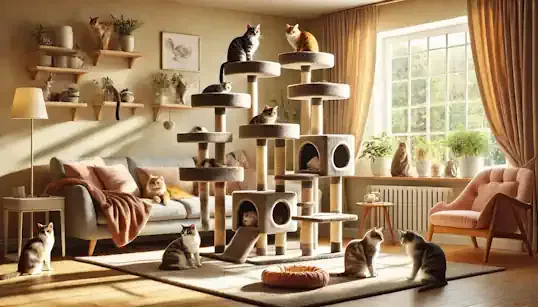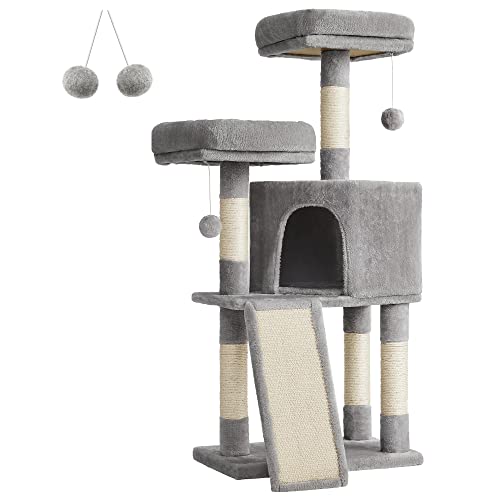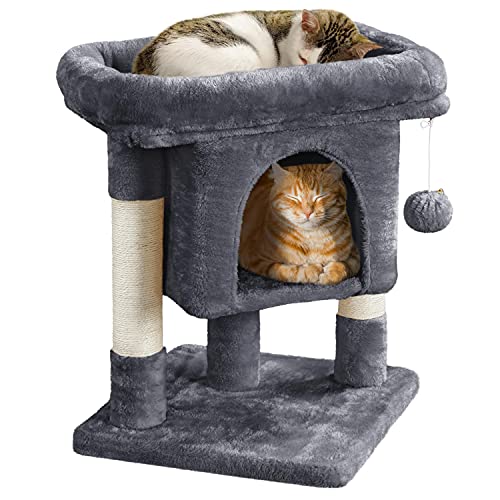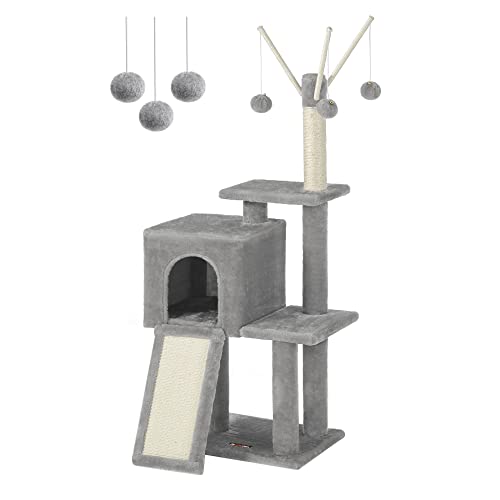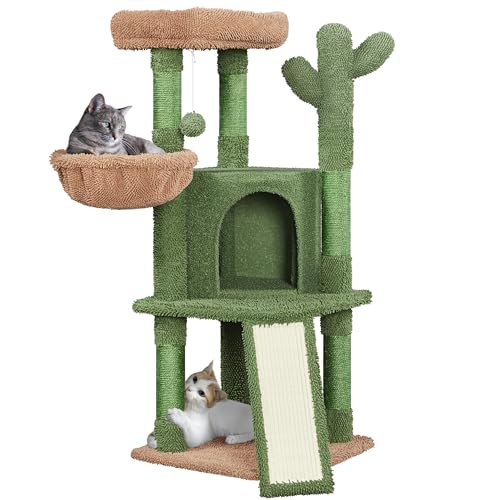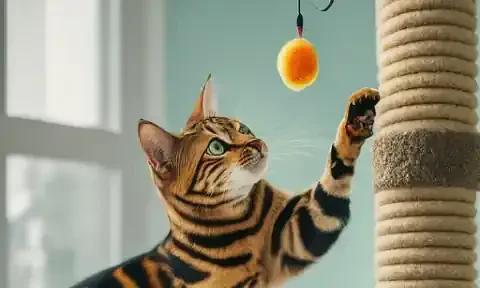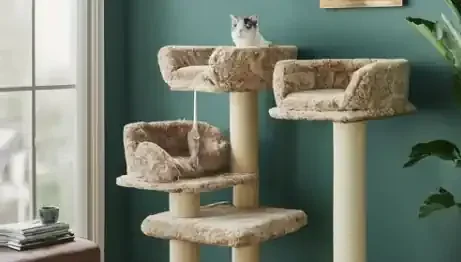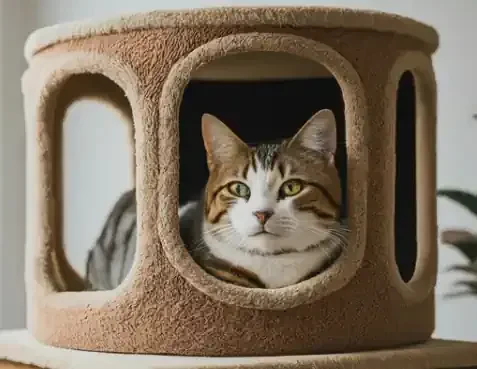Cat Trees -The Unique Needs Of A Multi-Cat Household
Multiple cat households are a unique dynamic, requiring special consideration when choosing a cat tree. Unlike single-cat homes where one cat's preferences dictate the ideal cat tree, multi-cat environments demand a versatile and accommodating structure to cater to the diverse needs of all feline residents.
A single cat tree, even a large one, may not suffice in a multi-cat household. It can quickly become a source of territorial disputes, with dominant cats hogging the prime spots and leaving less assertive felines with limited options. This can lead to stress, anxiety, and even aggression.
Cats are natural climbers and explorers, thriving in environments that offer both vertical and horizontal space. A multi-cat cat tree should provide ample opportunities for climbing, jumping, and perching at various heights. Additionally, horizontal platforms and lounging areas are essential for cats who prefer to relax and observe their surroundings from a comfortable vantage point.
Cats are also territorial creatures, and in a multi-cat household, it's crucial to provide them with multiple escape routes on the cat tree. This means incorporating several ramps, platforms, and openings at different levels, allowing cats to easily navigate the structure without feeling trapped or cornered. Multiple escape routes help reduce tension and prevent conflicts.
Cats have varying activity levels and preferences when it comes to play and relaxation. Some are energetic climbers and jumpers, while others prefer to lounge and nap. A multi-cat cat tree should cater to these diverse preferences by offering a combination of scratching posts, dangling toys, tunnels, and cozy napping spots. This ensures that all cats in the household find something to enjoy and can engage in their preferred activities.
Finally, in a multi-cat household, it's common to have cats of different sizes and weights. This means choosing a cat tree that can safely support the weight of all your feline companions. Look for a sturdy base and construction materials that can withstand the rigors of multiple cats climbing and jumping. Ensure that the platforms and perches are spacious enough for larger cats to comfortably stretch out, and that smaller cats have access to areas where they won't feel intimidated.
Key Features For A Multi-Cat Cat Tree
In a multi-cat household, the cat tree becomes more than just furniture; it's a central hub for activity, relaxation, and social interaction. Choosing a cat tree with the right features is essential to ensure it meets the diverse needs of your feline family and promotes harmony among them.
First and foremost, a sturdy base and construction are paramount. With multiple cats climbing, jumping, and playing, stability is key. A wobbly or unstable cat tree can be dangerous, risking injuries. Look for a cat tree with a wide, heavy base and solid construction materials like wood or high-quality compressed wood. Ensure the connections between components are secure and reinforced, so the tree can withstand energetic movements.
Cats have a natural instinct to scratch, and providing ample scratching options is crucial for keeping their claws healthy and preventing them from damaging your furniture. A multi-cat cat tree should include multiple scratching posts with different textures and materials, such as sisal rope, carpet, and corrugated cardboard. This variety caters to different scratching preferences and encourages cats to use the scratching posts instead of your sofa or curtains.
Cats love to climb and explore, so a multi-cat cat tree should offer a variety of levels and platforms to satisfy their adventurous spirit. Incorporate platforms at different heights, connected by ramps, stairs, or tunnels. This allows cats to easily navigate the structure and find their preferred spots for lounging, napping, or observing their surroundings.
As natural predators, cats enjoy surveying their territory from elevated positions. A multi-cat cat tree should include perches at varying heights, offering different vantage points. These can be platforms, hammocks, or even enclosed spaces like boxes or baskets. Varying the height and style of the perches adds visual interest and caters to different preferences among your cats.
Finally, in a multi-cat household, it's important to provide each cat with a private space where they can retreat and feel secure. This is especially crucial for shy or less assertive cats who may feel overwhelmed by the constant activity of their housemates. Incorporate hiding spots or cubbies into the cat tree, such as enclosed boxes, tunnels with covered exits, or hammocks with a roof. These private spaces offer a sense of security and allow cats to de-stress and recharge away from the hustle and bustle of the household.
Material And Durability Considerations
Choosing the right materials for a multi-cat cat tree is crucial not only for its aesthetic appeal but also for its longevity and the safety of your feline companions. With multiple cats using the cat tree daily, it's essential to prioritize materials that can withstand wear and tear while remaining safe and comfortable for your furry friends.
Cats are curious creatures and may nibble or lick the materials on their cat tree. Ensure that all materials used in the construction are non-toxic and safe for feline consumption. Avoid cat trees made with treated wood or fabrics containing harmful chemicals. Opt for natural materials like untreated wood, sisal rope, and organic cotton for scratching posts and coverings.
Scratching is a natural behavior for cats, and in a multi-cat household, scratching posts are bound to get a lot of use. Choose scratching posts made with durable materials like sisal rope or tightly woven carpet that can withstand frequent scratching without unraveling or fraying. Consider replacing individual scratching posts as they wear out to maintain the cat tree's appeal and functionality.
With multiple cats using the cat tree, spills and accidents are inevitable. Opt for fabrics that are stain-resistant and easy to clean, such as microfiber or outdoor fabrics. Avoid materials that shed easily, as loose fibers can be ingested by cats and cause digestive problems. Regularly vacuum and clean the cat tree to remove hair, debris, and stains.
To maintain a hygienic environment for your cats, choose platforms and perches that are easy to clean. Removable and washable covers are ideal, as they can be quickly thrown in the washing machine to remove dirt and odors. Avoid materials that trap hair and dirt, making cleaning difficult and time-consuming.
A multi-cat cat tree should be an investment that lasts for years. Look for a cat tree with solid construction and reinforced joints. Avoid cheaply made cat trees that may wobble, tip over, or break under the weight of multiple cats. Investing in a high-quality cat tree will save you money in the long run and ensure that your cats have a safe and enjoyable place to play and relax for years to come.
Safety Features To Prioritize
Safety is a paramount concern when selecting a cat tree for a multi-cat household. With multiple felines climbing, jumping, and playing, it's crucial to choose a cat tree that prioritizes safety to prevent accidents and injuries.
Avoid cat trees with dangling strings or toys. Cats are naturally playful and may be tempted to chew or swallow dangling strings or toys. These can pose a choking hazard or cause intestinal blockages if ingested. Opt for cat trees with securely attached toys or those that feature interactive elements like tunnels or scratching pads without loose parts.
The platforms and perches on a multi-cat cat tree should be securely attached to the main structure. Loose or wobbly platforms can cause cats to lose their balance and fall, leading to injuries. Check that all screws, bolts, and connections are tight and that the platforms are firmly anchored to the base and supporting posts.
A stable base is essential for preventing the cat tree from tipping over, especially when multiple cats are climbing and jumping. Ensure that the base is wide and heavy enough to provide adequate stability. Consider placing the cat tree against a wall for added support if needed.
Inspect the cat tree thoroughly for any sharp edges, protruding screws, or rough surfaces that could potentially injure your cats. Sand down any rough spots and cover exposed screws or bolts with caps to create a smooth and safe surface for your feline companions.
Over time, even the sturdiest cat tree can experience wear and tear. Make it a habit to regularly inspect the cat tree for any signs of damage, such as loose screws, frayed scratching posts, or worn-out fabric. Address any issues promptly to maintain the safety and integrity of the cat tree.
Additional Features To Enhance The Cat Tree Experience
While the essential features discussed earlier are crucial for a functional and safe multi-cat cat tree, several additional features can significantly enhance the overall experience for your feline companions. These extra touches can make the cat tree even more appealing, stimulating, and comfortable, ensuring that your cats get the most out of their new playground.
Interactive elements like hanging toys or tunnels can keep your cats entertained and engaged. Cats are naturally playful creatures, and incorporating these elements can provide hours of amusement. Hanging toys, such as dangling feathers, balls, or mice, can be batted around, while tunnels offer a fun and exciting way for cats to explore and play hide-and-seek with each other.
For added convenience, consider a cat tree with built-in food and water bowls. Placing them on the cat tree can encourage cats to spend more time there and make it a central hub for their daily activities. This can be particularly beneficial for timid cats who may feel more comfortable eating and drinking in an elevated and secure location.
Cats love to nap and lounge, and providing soft and plush bedding on the cat tree's platforms and perches can make it even more inviting. Look for materials like faux fur, fleece, or sherpa that are soft to the touch and provide warmth and comfort.
During colder months, a heated bed can be a welcome addition to the cat tree. It provides a cozy and warm spot for cats to curl up and relax, especially for senior cats or those with arthritis who may benefit from the extra warmth.
Finally, catnip is a natural herb that many cats find irresistible. Incorporating scratching posts infused with catnip can entice cats to use them, promoting healthy scratching behavior and deterring them from scratching furniture.
Tips For Choosing And Placing The Cat Tree
Selecting and positioning the perfect cat tree for your multi-cat household involves more than just picking a visually appealing design. It requires thoughtful consideration of your cats' personalities, habits, and the available space in your home.
Before you start browsing cat trees, measure the available space in your home where you intend to place it. Consider the height, width, and depth of the area to ensure that the cat tree fits comfortably without obstructing walkways or causing clutter.
Take into account the existing furniture in the room where the cat tree will be located. Ensure that there is enough space around the cat tree for cats to jump and climb without bumping into other objects. Also, consider the proximity to windows, doors, and other areas of interest for your cats.
Cats love to observe their surroundings, so placing the cat tree near a window can provide them with endless entertainment as they watch birds, squirrels, and other outdoor activities. Alternatively, position it near a frequently used area in your home, such as the living room or kitchen, so your cats can feel included in the household activities.
When you bring home a new cat tree, introduce it to your cats gradually. Start by placing it in a familiar area of your home and let your cats explore it at their own pace. You can encourage them to use it by placing treats or toys on the platforms and perches.
If your cats are hesitant to use the new cat tree, try enticing them with treats or toys. Sprinkle catnip on the scratching posts or dangle a feather toy from one of the perches. Positive reinforcement can help create positive associations with the cat tree and encourage your cats to use it regularly.
Summary
Selecting the ideal cat tree for a multi-cat household requires a thoughtful approach that considers the unique needs and dynamics of feline cohabitation. Unlike single-cat homes, where one cat's preferences dictate the ideal cat tree, multi-cat environments demand a versatile and accommodating structure to cater to the diverse needs of all feline residents. Understanding the distinct requirements of a multi-cat household, prioritizing key features, choosing durable materials, ensuring safety, and incorporating additional elements can collectively create a haven for your feline companions, fostering harmony and enriching their lives.
